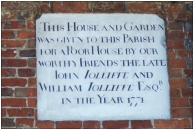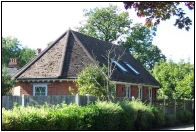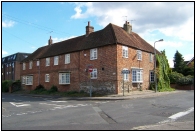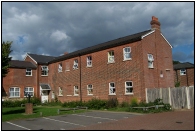| |
 
PETERSFIELD
ALMSHOUSES AND THE WORKHOUSE
The very word Workhouse puts us in mind of the
grim world of Oliver Twist. But in Petersfield,
as elsewhere, its story is an intriguing mixture
of social history, politics, economics and
architecture.
In 1601, the last year of Elizabeth I’s
reign, a Poor Law Act gave responsibility to
local parishes for looking after the poor, who
could claim assistance from the parish’s
householders. The old, lame and helpless might be
provided with accommodation in almshouses.
Twenty years later William Antrobus left money to
build what became known as the Antrobus Alms
Houses in College Street. Unfortunately there was
not sufficient money to set up an alms trust, and
so maintenance was always a problem. By the early
part of the 20th century they had fallen into a
parlous state, but some will remember the
roofless building adjoining Luker’s Brewery.
The remaining walls were pulled down at the time
of the development of the one way system in Tor
Way.
 |
|
In 1771
Petersfield’s leading family, the
Jolliffes, presented an L shaped group of
cottages in Swan Street to the parish for
use as a local workhouse. The plaque of
the time reads: “This house and
garden was given to the parish as a Poor
House by our worthy friends the late John
Jolliffe and William Jolliffe Esq. in the
year 1771.”
Twenty-five years on, Sir Frederick Eden
recorded that the Workhouse was under the
superintendence of an overseer, who did
not live in the house but attended meals,
provided victuals and collected the
Poor’s Rates. He was disliked by the
poor and apparently several attempts were
made to burn his own house down. |
Understandably so, perhaps,
when the diet consisted of bread and milk every
day for breakfast, pickled pork, pudding and
vegetables for lunch andbread and cheese for
supper. Half a pound of cheese a week was allowed
for each grown person.
Twenty-two people, mainly old women and children
lived in the house, principally employed in
cleaning the streets, but in the winter as many
as fifty people lived there.
The Poor Law Amendment Act of 1834 aimed to deter
the able-bodied from claiming poor relief, but
once more to provide refuge for the ailing and
destitute. Parishes joined together to form
Unions, with a large workhouse that would cater
for all categories of pauper. In return for a
roof, inmates were made to work hard in large
houses or inns.
The Petersfield Poor Law Union was formed in
1835, consisting of thirteen constituent
parishes, and the new Workhouse was built
immediately near the end of Love lane. It housed
seventy-eight inmates and ten officers, a master
and a matron. It was overseen by a Board of
sixteen elected Guardians. At the end of the
century a Chapel was built on the north side.
Workhouses were officially abolished in 1930, but
many, including Petersfield’s, continued to
operate virtually unaltered. Indeed, it took a
German bomb to hasten its demise, when on 21
November 1940 the front of the building took a
direct hit, killing eight people, including the
master and matron.
The remaining buildings were turned into a
welfare centre, until the whole site, including
the chapel, was converted into affordable housing
in 1997, ending a long chapter of
Petersfield’s history.
  
Tom Muckley
This article was originally
published by the
Petersfield Post
tommuckley.co.uk
|
|





